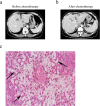Splenic enlargement induced by preoperative chemotherapy is a useful indicator for predicting liver regeneration after resection for colorectal liver metastases
- PMID: 32576191
- PMCID: PMC7313099
- DOI: 10.1186/s12957-020-01918-4
Splenic enlargement induced by preoperative chemotherapy is a useful indicator for predicting liver regeneration after resection for colorectal liver metastases
Abstract
Background: Conversion chemotherapy may downsize unresectable colorectal liver metastases (CRLMs), but may cause liver injury and splenic enlargement. The effect of preoperative chemotherapy on liver regeneration after liver resection remains undetermined. The aim of this study was to examine whether splenic enlargement induced by preoperative chemotherapy is an indicator to identify high-risk patients for impaired liver regeneration and liver dysfunction after resection.
Methods: We retrospectively reviewed 118 Japanese patients with CRLMs. Fifty-one patients had conversion chemotherapy. The other 67 patients underwent up-front liver resection. We clarified effects of conversion chemotherapy on splenic volume, liver function, and postoperative liver regeneration. Perioperative outcome was also analyzed.
Results: A ratio of the splenic volume before and after chemotherapy (SP index) in the oxaliplatin-based chemotherapy group was significantly greater than other chemotherapy groups after 9 or more chemotherapy cycles. Patients whose SP index was 1.2 or more had significantly higher indocyanine green retention rate at 15 min (ICG-R15) than patients without chemotherapy. Analyses of covariance showed liver regeneration rate after resection was decreased in patients whose SP index was 1.2 or more. The incidence of postoperative liver dysfunction in patients whose SP index was 1.2 or more was significantly greater than patients without chemotherapy. Multivariate analysis showed SP index was a significant predictive factor of impaired liver regeneration.
Conclusions: Splenic enlargement induced by preoperative chemotherapy was a useful indicator for impaired liver regeneration after resection and a decision-making tool of treatment strategy for unresectable CRLMs.
Keywords: Colorectal liver metastases; Conversion chemotherapy; Hepatectomy; Liver regeneration; Splenomegaly.
Conflict of interest statement
The authors declare that they have no competing interests.
Figures



Similar articles
-
Tumor progression while on chemotherapy: a contraindication to liver resection for multiple colorectal metastases?Ann Surg. 2004 Dec;240(6):1052-61; discussion 1061-4. doi: 10.1097/01.sla.0000145964.08365.01. Ann Surg. 2004. PMID: 15570210 Free PMC article.
-
Histological liver injury and surgical outcome after FOLFOX followed by a hepatectomy for colorectal liver metastases in Japanese patients.Int J Clin Oncol. 2010 Jun;15(3):263-70. doi: 10.1007/s10147-010-0046-9. Epub 2010 Mar 19. Int J Clin Oncol. 2010. PMID: 20238233
-
Sinusoidal injury increases morbidity after major hepatectomy in patients with colorectal liver metastases receiving preoperative chemotherapy.Ann Surg. 2008 Jan;247(1):118-24. doi: 10.1097/SLA.0b013e31815774de. Ann Surg. 2008. PMID: 18156931
-
OncoSurge: a strategy for long-term survival in metastatic colorectal cancer.Colorectal Dis. 2003 Nov;5 Suppl 3:20-8. doi: 10.1046/j.1463-1318.5.s3.1.x. Colorectal Dis. 2003. PMID: 23573557 Review.
-
Chemotherapy and surgery: new perspectives on the treatment of unresectable liver metastases.Ann Oncol. 2003;14 Suppl 2:ii13-6. doi: 10.1093/annonc/mdg731. Ann Oncol. 2003. PMID: 12810452 Review.
Cited by
-
CBX7 silencing promoted liver regeneration by interacting with BMI1 and activating the Nrf2/ARE signaling pathway.Sci Rep. 2024 May 14;14(1):11008. doi: 10.1038/s41598-024-58248-8. Sci Rep. 2024. PMID: 38744845 Free PMC article.
-
Splenic hypertrophy predicts liver-specific complications in patients undergoing major liver resection for colorectal liver metastases, after preoperative chemotherapy.Hepatobiliary Surg Nutr. 2025 Jun 1;14(3):411-422. doi: 10.21037/hbsn-24-121. Epub 2024 Sep 18. Hepatobiliary Surg Nutr. 2025. PMID: 40529910 Free PMC article.
References
-
- Kopetz S, Chang GJ, Overman MJ, Eng C, Sargent DJ, Larson DW, et al. Improved survival in metastatic colorectal cancer is associated with adoption of hepatic resection and improved chemotherapy. Journal of clinical oncology : official journal of the American Society of Clinical Oncology. 2009;27(22):3677–3683. doi: 10.1200/JCO.2008.20.5278. - DOI - PMC - PubMed
-
- Tournigand C, Andre T, Achille E, Lledo G, Flesh M, Mery-Mignard D, et al. FOLFIRI followed by FOLFOX6 or the reverse sequence in advanced colorectal cancer: a randomized GERCOR study. Journal of clinical oncology : official journal of the American Society of Clinical Oncology. 2004;22(2):229–237. doi: 10.1200/JCO.2004.05.113. - DOI - PubMed
-
- Bokemeyer C, Bondarenko I, Hartmann JT, de Braud F, Schuch G, Zubel A, et al. Efficacy according to biomarker status of cetuximab plus FOLFOX-4 as first-line treatment for metastatic colorectal cancer: the OPUS study. Annals of oncology: official journal of the European Society for Medical Oncology / ESMO. 2011;22(7):1535–1546. doi: 10.1093/annonc/mdq632. - DOI - PubMed
-
- Folprecht G, Gruenberger T, Bechstein WO, Raab HR, Lordick F, Hartmann JT, et al. Tumour response and secondary resectability of colorectal liver metastases following neoadjuvant chemotherapy with cetuximab: the CELIM randomised phase 2 trial. Lancet Oncol. 2010;11(1):38–47. doi: 10.1016/S1470-2045(09)70330-4. - DOI - PubMed
-
- Wong R, Cunningham D, Barbachano Y, Saffery C, Valle J, Hickish T, et al. A multicentre study of capecitabine, oxaliplatin plus bevacizumab as perioperative treatment of patients with poor-risk colorectal liver-only metastases not selected for upfront resection. Annals of oncology: official journal of the European Society for Medical Oncology / ESMO. 2011;22(9):2042–2048. doi: 10.1093/annonc/mdq714. - DOI - PubMed
MeSH terms
Substances
LinkOut - more resources
Full Text Sources
Medical

